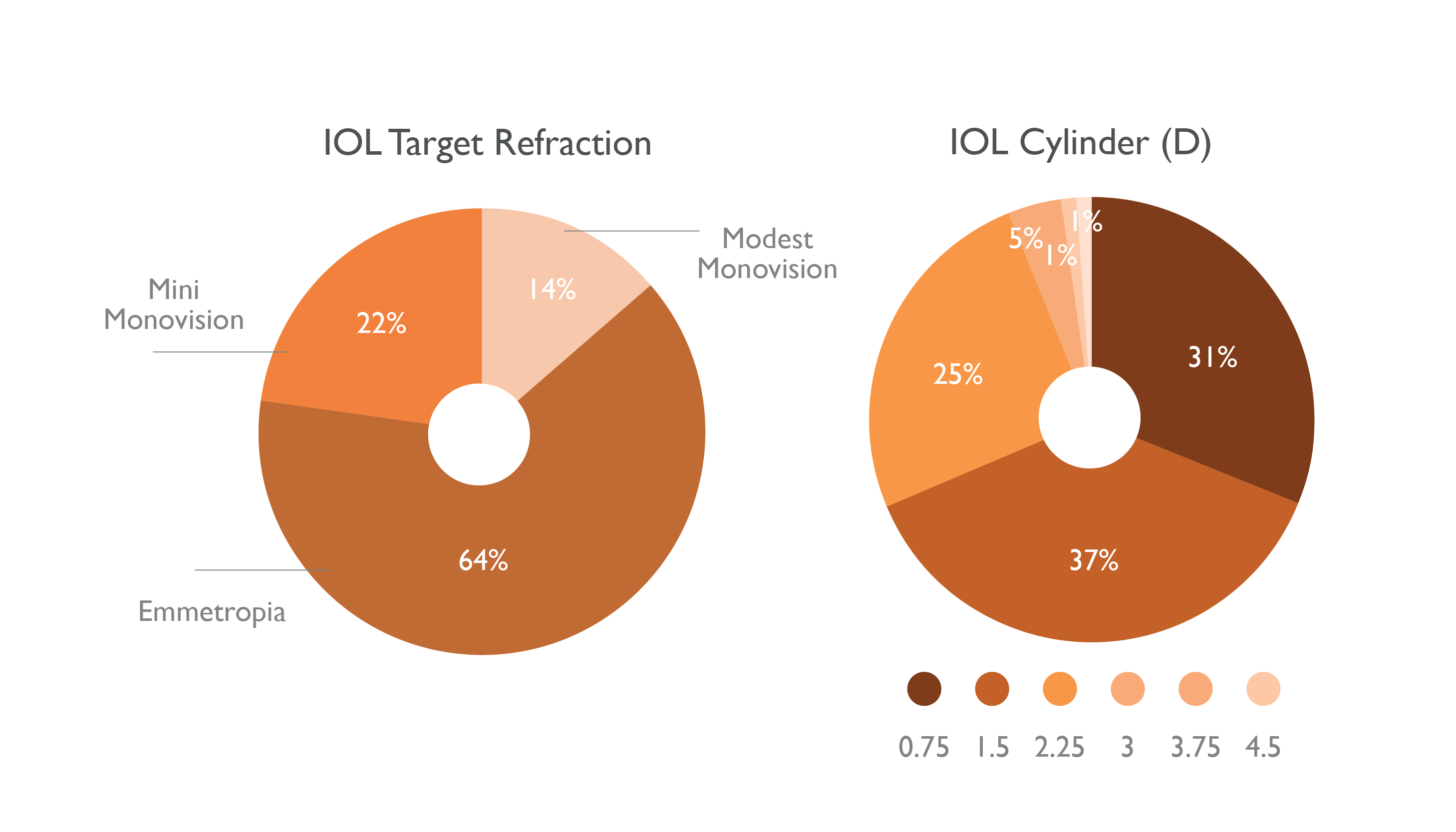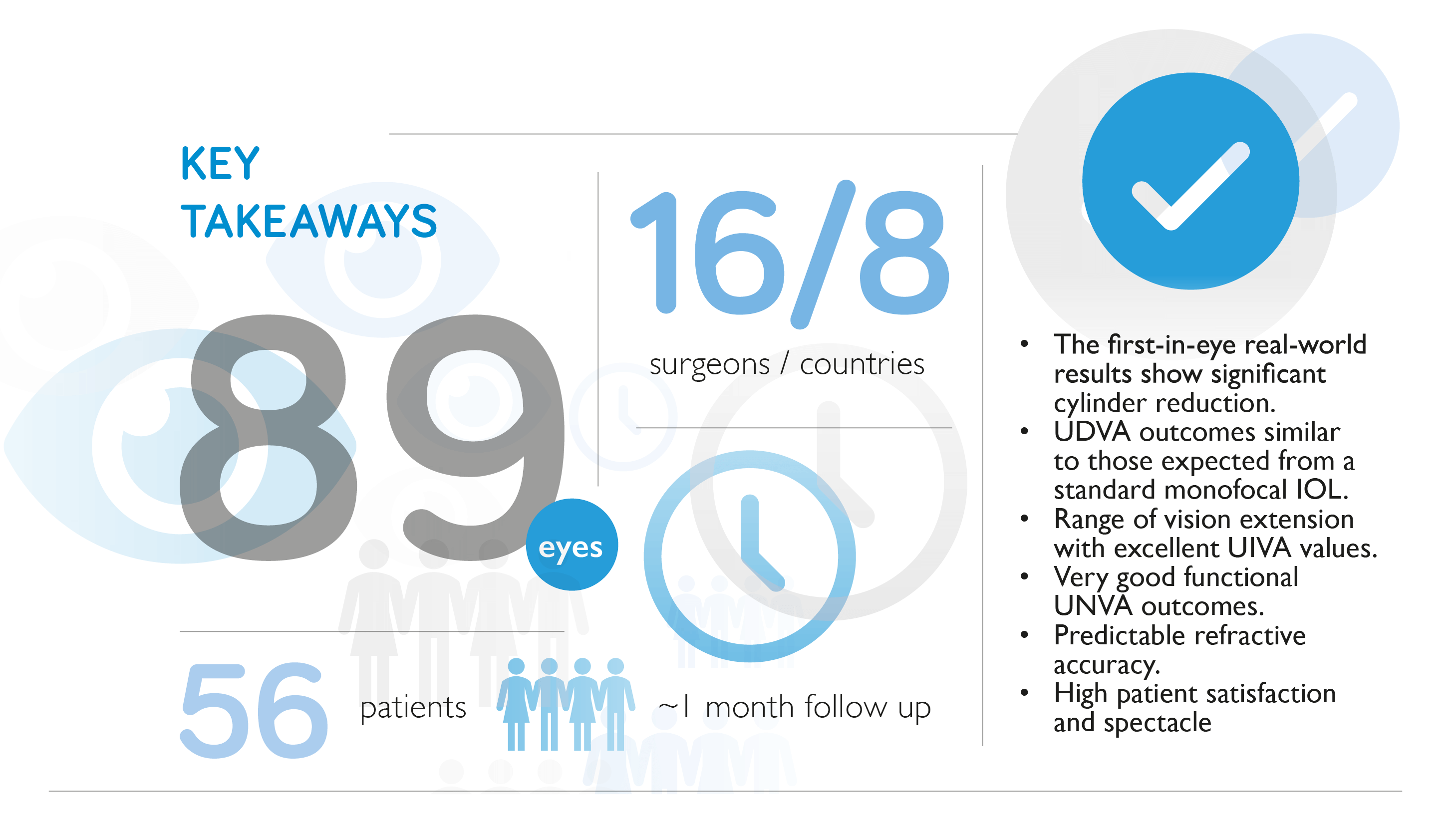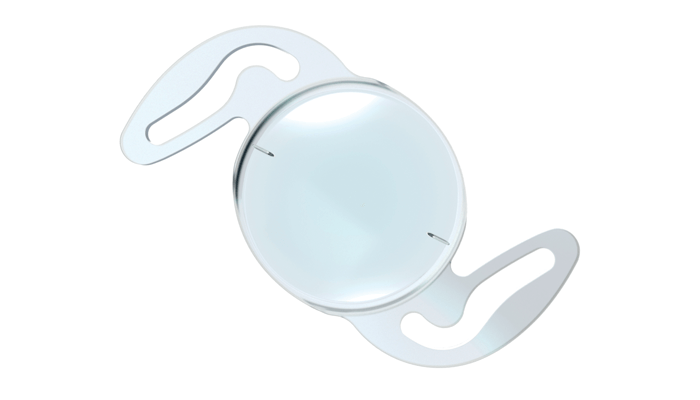While standard monofocal IOLs provide excellent distance visual acuity, they don’t provide spectacle independence for patients at intermediate and near distances. Multifocal IOLs do increase spectacle independence but can lead to unwanted photic phenomena and reduced contrast sensitivity. Advances in non-diffractive optics have brought innovations such as Rayner’s CE-marked and FDA-approved RayOne EMV lenses – non-diffractive enhanced monofocal aspheric IOLs designed to extend the range of vision beyond that of a standard monofocal IOL while minimizing visual disturbances. However, in order to achieve excellent visual acuity, reliable reduction of astigmatism must also be considered. As Allon Barsam – Director and Co-founder of OCL Vision and the first surgeon in the world to implant the original RayOne EMV lens – said in a recent webinar, he and many other surgeons were “chomping at the bit” to get the toric version of the RayOne EMV, so that they could “aggressively treat astigmatism, reducing it as much as possible to achieve the best range, quality, and level of vision.”
In September 2022, the toric version of the RayOne EMV became available in CE mark accepting countries, offering a wide range of cylinder correction for treating patients with astigmatism. The RayOne EMV Toric differs from other enhanced monofocal IOLs by intentionally introducing controlled positive spherical aberration to spread light along the visual axis and elongate the focal range from far into intermediate distances, delivering up to 1.5 D of high-quality vision.
The results of a recent first-in-eye, multicenter evaluation – to evaluate the visual and refractive outcomes, and patient satisfaction, after unilateral or bilateral implantation of the RayOne EMV Toric – should very much satisfy those surgeons who want to treat astigmatism effectively. Involving 16 surgeons across eight countries and 56 patients (89 eyes) – that is, 33 patients (66 eyes) implanted bilaterally, and 23 patients (23 eyes) implanted unilaterally – the evaluation shows that the RayOne EMV Toric achieves:
significant cylinder reduction
uncorrected distance visual acuity (UDVA) similar to that expected from a standard monofocal IOL
range of vision extension with excellent uncorrected intermediate visual acuity (UIVA) values
very good functional uncorrected near visual acuity (UNVA) outcomes
predictable refractive accuracy
high patient satisfaction and spectacle independence rates.
 Figure 1 RayOne EMV Toric target refraction and IOL cylinder
Figure 1 RayOne EMV Toric target refraction and IOL cylinder
Refractive and visual outcomes
Barsam – one of the surgeons who participated in the first-in-eye evaluation – explains that the average patient was preoperatively slightly hyperopic but patients fell across the whole range from almost 3 D of hyperopia to low myopia. The majority of patients were targeted for emmetropia (64% of eyes), 22% were targeted for mini-monovision (-0.25 D to -0.75 D), and 14% for modest monovision (-0.75 D to -1.5 D) – see Figure 1. Barsam adds however that the evaluation did not target emmetropia in all patients “because we wanted to make it applicable to the real world and we already knew that the RayOne EMV works very well when you target a small amount of myopia in the non-dominant eye.”

The refractive outcomes from the evaluation demonstrated excellent cylinder correction, with 63% of eyes with less than 0.25 D of manifest astigmatism at one-month after surgery and 74% of eyes with less than 0.50 D of manifest astigmatism (Figure 2). The cylindrical correction was shown to be effective across a broad range of corneal astigmatism, with cylindrical powers on the IOL plane between 0.75 D and up to 4.5 D used in this group of eyes.
The visual outcomes showed that implantation of the RayOne EMV Toric yields distance vision comparable to a standard monofocal IOL. Mean binocular UDVA was 0.00 ± 0.07 logMAR and all patients could see 0.2 logMAR or better. Likewise, mean binocular UIVA was 0.07 ± 0.14 logMAR with 92% of patients achieving 0.2 logMAR or better. Uncorrected intermediate vision was excellent, and uncorrected near vision was very good (Figure 3). At near, 77% of patients had a binocular UNVA of 0.3 logMAR (20/40) or better, and 87% of patients had a binocular UNVA of 0.4 logMAR (20/50) or better. The visual and refractive outcomes are consistent with individual evaluations of the RayOne EMV Toric by Allon Barsam and Gerd Auffarth.
Postoperatively, patients ended up with a very reduced refractive cylinder. Barsam adds that despite it being difficult to entirely eliminate astigmatism – for a variety of reasons – real word data with RayOne EMV Toric shows astigmatism correction to exceed NHS benchmarks.
Patient and surgeon satisfaction
Most patients experienced no unwanted photic phenomena after the surgery: 96% reported no visual disturbances at daytime and 89% reported no visual disturbances at night. Patient satisfaction after surgery was excellent, with 94% of patients reporting being satisfied or very satisfied. Of the three reported adverse events in three eyes, none were considered related to the IOL and no IOL was explanted during the evaluation. Only one patient (2 eyes) was dissatisfied, but, as Barsam explains, this patient had a preoperative corneal scar and it is possible that this dissatisfaction may be attributed to this ocular surface problem, which can be addressed and potentially resolved over the long term.
Complete spectacle independence was achieved for distance, and intermediate in 91% of patients. 51% of patients said they did not require any spectacle correction at any distance. Only one patient required spectacle correction for intermediate, and 37% of patients required spectacle aid for near tasks only.
In a feedback questionnaire, participating surgeons reported observing no rotation of the IOL from the target axis in 99% of cases. The surgeons said that the lens design demonstrated excellent usability. All surgeons rated the usability of the preloaded injector, as well as the IOL delivery and positioning, as excellent or good. Moreover, the intraoperative stability of the IOL was consistently assessed as excellent and the alignment markings on the toric IOL were highly visible to the surgeons, aiding in accurate placement.
A clearer future
Traditionally, the primary goal of cataract surgery with monofocal lenses has been to attain optimal distance visual acuity. More recently, advancements in IOLs have expanded patients’ and surgeons’ aspirations – the aim is now to improve patients’ well-being and enable them, even if they have astigmatism, to comfortably engage in daily activities like driving, using their smartphones, and take part in hobbies such as reading and sewing. Looking at the impact on patients’ day-to-day lives, Barsam reminds us that more than 50% of patients who received the RayOne EMV Toric no longer have to use glasses for any activity. A third of patients have to use glasses just for small print, “which can be off-the-shelf readers of, say +1.” Barsam adds that “most patients are very happy with this when they don’t have to worry about glare or halos at night, which is the case with a multifocal or trifocal lens.”

The RayOne EMV Toric enhanced monofocal toric IOL provides patients with excellent distance and intermediate vision along with very good functional near vision. Its rotationally stable platform ensures effective astigmatism correction, with cylindrical power from 0.75 D to 4.50 D on the IOL plane, further amplified by the benefits of the enhanced monofocal optic. The real-world results obtained from the multicenter evaluation establish the newly launched RayOne EMV Toric lens as an innovative and powerful refractive option. Its seamless integration into ophthalmologists’ clinical workflow will help patients to achieve spectacle independence at both distance and intermediate vision.




